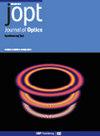降低纳米光子元件三维形状优化的计算成本
IF 2.7
4区 物理与天体物理
Q3 OPTICS
引用次数: 0
摘要
逆向设计方法可有效优化光子设备的许多设计参数,从而在一个典型的非凸参数空间中发现局部最优设计。通常,在制造之前还需要考虑各种次要目标(性能指标)。因此,大量的优化设计是非常有用的,因为它们在次要目标上的表现往往各不相同。对于某些类别的元件,如形状优化器件,最有效的优化方法是从随机参数初始化开始进行二维优化,然后再进行三维再优化。然而,后一阶段需要大量的时间和资源。因此,通过重复三维优化来获得所需的优化设计集合是一项计算挑战。为解决这一问题,我们提出了一种基于机器学习的回归模型,以降低三维优化阶段的计算成本。该回归模型基于一个小型数据集,将二维和三维优化结构参数关联起来。使用该模型预测的设计参数作为三维优化的初始条件,可以更快地达到相同的最优值。TE0-TE1 模式转换器是模分复用应用中的一个重要组件,基于形状优化的反向设计证明了这种方法的有效性。两种方法的最终优化设计完全相同,但利用基于机器学习的回归模型,三维优化步骤的计算量减少了 35%。这种方法为大量三维优化设计提供了更有效的采样手段。本文章由计算机程序翻译,如有差异,请以英文原文为准。
Computation cost reduction in 3D shape optimization of nanophotonic components
Inverse design methodologies effectively optimize many design parameters of a photonic device with respect to a primary objective, uncovering locally optimal designs in a typically non-convex parameter space. Often, a variety of secondary objectives (performance metrics) also need to be considered before fabrication takes place. Hence, a large collection of optimized designs is useful, as their performance on secondary objectives often varies. For certain classes of components such as shape-optimized devices, the most efficient optimization approach is to begin with 2D optimization from random parameter initialization and then follow up with 3D re-optimization. Nevertheless, the latter stage is substantially time- and resource-intensive. Thus, obtaining a desired collection of optimized designs through repeated 3D optimizations is a computational challenge. To address this issue, a machine learning-based regression model is proposed to reduce the computation cost involved in the 3D optimization stage. The regression model correlates the 2D and 3D optimized structural parameters based on a small dataset. Using the predicted design parameters from this model as the initial condition for 3D optimization, the same optima are reached faster. The effectiveness of this approach is demonstrated in the shape optimization-based inverse design of TE0-TE1 mode converters, an important component in mode-division multiplexing applications. The final optimized designs are identical in both approaches, but leveraging a machine learning-based regression model offers a 35% reduction in computation load for the 3D optimization step. The approach provides a more effective means for sampling larger numbers of 3D optimized designs.
求助全文
通过发布文献求助,成功后即可免费获取论文全文。
去求助
来源期刊

Journal of Optics
OPTICS-
CiteScore
4.50
自引率
4.80%
发文量
237
审稿时长
1.9 months
期刊介绍:
Journal of Optics publishes new experimental and theoretical research across all areas of pure and applied optics, both modern and classical. Research areas are categorised as:
Nanophotonics and plasmonics
Metamaterials and structured photonic materials
Quantum photonics
Biophotonics
Light-matter interactions
Nonlinear and ultrafast optics
Propagation, diffraction and scattering
Optical communication
Integrated optics
Photovoltaics and energy harvesting
We discourage incremental advances, purely numerical simulations without any validation, or research without a strong optics advance, e.g. computer algorithms applied to optical and imaging processes, equipment designs or material fabrication.
 求助内容:
求助内容: 应助结果提醒方式:
应助结果提醒方式:


